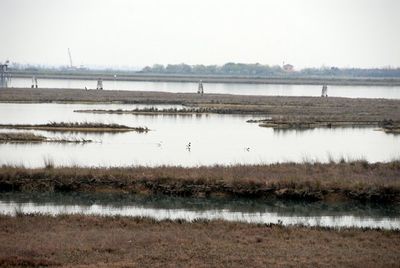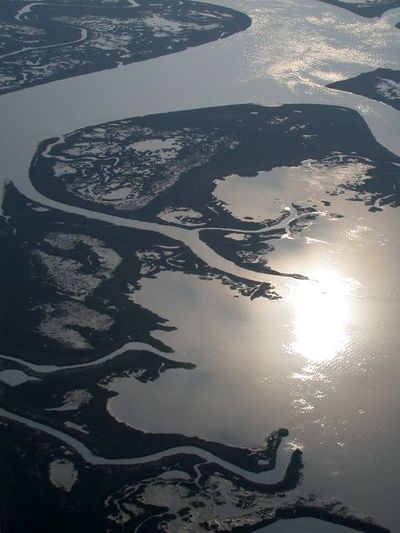Difference between revisions of "Coastal lagoon"
Dronkers J (talk | contribs) |
Dronkers J (talk | contribs) |
||
| Line 42: | Line 42: | ||
'''References''' | '''References''' | ||
<references/> | <references/> | ||
| + | |||
| + | |||
| + | [[Category:Physical coastal and marine processes]] | ||
| + | [[Category:Coastal and marine ecosystems]] | ||
Latest revision as of 20:33, 27 February 2020
Coastal lagoons are transitional zones between land and sea: they are shallow inland water bodies, separated from the ocean by a barrier, connected to the ocean by one or more restricted inlets which remain open at least intermittently [1].
Most of coastal lagoons formed as a result of the Late Quaternary marine transgression, which begun approximately 18,000 years ago and finished about 3,000 years ago, leaving a mean sea level close to the present. The building of the coastal barriers was due to the interaction of river sediments (transported in large quantity in the period of the melting of snowfields) with the marine processes (winds, currents and waves).
Once formed, lagoons are modified by erosion and deposition. Some of the coastal lagoons known in historical times have been infilled by accumulation of inwashed sediments and organic deposits (e.g. in the Anzio district, and along the Adriatic coastline, in Italy). Elsewhere, the marine erosion of the seaward barrier reduced former lagoons to marine bays. Coastal lagoons have a transitory 'natural' character, being subjected to rapid geomorphologic evolution. The main drivers of this evolution are the rates of sediment supply and the relative sea-level rise. The actual sea-level depends on the combined effect of eustatism (rising of the mean sea level) and subsidence (lowering of the basin bottom).
Coastal lagoons present a great variety of dimensions, from 10,000 sq m to 10,000 sq km (Lagoa dos Patos, Brazil). The largest in the Mediterranean Sea is the Lagoon of Venice (600 sq km), while in the Baltic Sea the largest is the Curonian lagoon is 1,600 sq km. They show a wide range of ecological variation, too.
Coastal lagoons can be classified in different ways, according to their:
- a) mean salinity ( freshwater, oligo- meso-, poly-, eu-haline, hypersaline)
- b) tidal regime ( non-, micro- meso- macro- tidal)
- c) geomorphic type, i.e. related to the water exchange with the sea (chocked, restricted and leaky)
They are also considered 'transitional water systems', term that was introduced by the European Union (European Water Framework Directive 2000/60/EC) to include all types of waters which were neither freshwater nor marine but are brackish or hyperhaline, including rias, fjords, fjards, estuaries and lagoons [2][3][4].
Coastal lagoon habitat is classified and under Directive 92/43/EEC on the conservation of natural habitats and wild flora and fauna (Habitats Directive). Furthermore, numerous bird species breed in coastal lagoons. As a result, many lagoons are also protected under Directive 2009/147/EC on the conservation of birds (Birds Directive).
Euro-Mediterranean lagoons have been managed since recorded times enhancing their natural heritage while delivering economic and societal benefits, until the equilibrium was broken by increasingly strong anthropogenic pressures, social and cultural changes.
In fact, lagoons are treasured ecosystems, being amongst the most productive and valuable environments in the Biosphere, and providing to the present society not only valuable ecosystem services, but also presenting very often an high cultural heritage value.
Due to their transitional nature, coastal lagoons are considered naturally stressed systems that experience frequent environmental disturbances and fluctuations [5][6][1][7]. Lagoons are now dramatically affected by habitat loss and modification, physical alteration, organic, chemical and biological pollution and overexploitation (as exogenic unmanaged pressures and endogenic managed pressures, sensu [8]. Pathways of vulnerability of lagoon ecosystems to anthropogenic drivers such as urbanisation and industrialisation are qualitatively well defined, even if the underlying mechanisms and the quantitative relationships are still unclear. Moreover, as ecotone ecosystems which are open and connected with both freshwater and marine ones, lagoons are among the most exposed aquatic ecosystems to current and foreseen climate changes.
Coastal lagoons can be considered also as as 'Sentinel Systems' for climate change, i.e. systems that responds to particular stressor(s) with changes across geographic gradients (NOAA, 2009).
Climate change will have several effects on lagoon ecosystems, including changes in water temperature, freshwater inputs and their temporal patterns, and seawater inputs [9]. Low water discharges, in Southern Europe, and flash-flooding events, in North-Eastern Europe, are expected to increase changes in species distribution and abundance, biodiversity and ecosystem functioning. Further changes are expected in transitional and lagoon ecosystems resulting from adaptation to climate changes that affect critical environmental conditions, such as temperature, dissolved oxygen, salinity, element concentrations and hydrology.
Being more confined than other transitional waters, lagoons are particularly sensitive to these changing pressures, mainly in the most reactive transitional zones, which are located at interfaces, e.g. terrestrial-aquatic, freshwater-marine, sediment-water column, lagoon waters - atmosphere [10].
See also Morphology of estuaries
References
- ↑ 1.0 1.1 Kjerfve, B. (Editor) 1994. Coastal Lagoon Processes. Elsevier Oceanographic Series 60
- ↑ Basset, A., Carrada, G.C. 2007. Editorial. Transitional Waters Bulletin 1: 1–2
- ↑ McLusky, D. and Elliott, M. 2007. Transitional waters: A new approach, semantics or just muddying the waters? Estuarine Coastal and Shelf Science 71(3):359-363
- ↑ Elliott, M. and Whitfield, A.K. 2011. Challenging paradigms in estuarine ecology and management. Estuarine Estuarine Coastal and Shelf Science 94(4):306-314
- ↑ Barnes, R.S.K. 1980. Coastal lagoons. Cambridge Univ. Press
- ↑ UNESCO, 1980. Coastal Lagoon Survey. Technical Papers in Marine Science 31
- ↑ Gamito, S. and Gilabert, J. 2005. Effects of changing environmental conditions on lagoon ecology. Diego, CM
- ↑ Borja, Á., Elliott, M., Carstensen, J., Heiskanen, A.-S. and van de Bund, W., 2010. Marinemanagement – towards an integrated implementation of the European marinestrategy framework and the water framework directives. Marine Pollution Bulletin 60: 2175–2186
- ↑ Eisenreich, S.J., Bernasconi, C. and Campostrini, P. 2005 Climate Change and the European Water Dimension Climate change and the European water dimension. Editor: European CommissionISBN: 92-894-9005-5
- ↑ Ewel, K.C., Cressa, C., Kneib, R.T., Lake, P.S., Levin, L.A., Palmer, M.A., Snelgrove, P. and Wall, D.H. 2001. Managing critical transition zones. Ecosystems 4: 452-460

